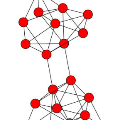Result relevance prediction is an essential task of e-commerce search engines to boost the utility of search engines and ensure smooth user experience. The last few years eyewitnessed a flurry of research on the use of Transformer-style models and deep text-match models to improve relevance. However, these two types of models ignored the inherent bipartite network structures that are ubiquitous in e-commerce search logs, making these models ineffective. We propose in this paper a novel Second-order Relevance, which is fundamentally different from the previous First-order Relevance, to improve result relevance prediction. We design, for the first time, an end-to-end First-and-Second-order Relevance prediction model for e-commerce item relevance. The model is augmented by the neighborhood structures of bipartite networks that are built using the information of user behavioral feedback, including clicks and purchases. To ensure that edges accurately encode relevance information, we introduce external knowledge generated from BERT to refine the network of user behaviors. This allows the new model to integrate information from neighboring items and queries, which are highly relevant to the focus query-item pair under consideration. Results of offline experiments showed that the new model significantly improved the prediction accuracy in terms of human relevance judgment. An ablation study showed that the First-and-Second-order model gained a 4.3% average gain over the First-order model. Results of an online A/B test revealed that the new model derived more commercial benefits compared to the base model.
翻译:成果相关性预测是电子商务搜索引擎的一项基本任务,目的是提高搜索引擎的效用,并确保用户经验的顺利使用。在过去几年里,目击了对使用变式型模型和深文本匹配模型的研究,以提高相关性。然而,这两类模型忽视了电子商务搜索日志中普遍存在的固有的双方网络结构,使这些模型无效。我们在本文件中提议了一个新的第二级相关性第二级引擎,这与先前的第一阶相关性基本不同,以改善结果相关性预测。我们第一次为电子商务项目的相关性设计了一个端至端一至二阶相关性预测模型。通过使用用户行为反馈信息(包括点击和购买)建立的双方网络的周边结构,该模型得到了增强。为了确保优势准确记录相关性信息,我们从BERT中引入了外部知识,以完善用户行为模式网络。这样,新的模型将邻接项目和查询信息整合起来,这对在考虑的首级模型和第二阶项目之间的重点查询具有高度相关性。在第一阶底部预测中,通过双方网络网络的周边结构结构结构结构结构扩大了该模型的扩展。在初步预测中获得了新的模型/后期预测结果。在第二个日历中获得了一个大大改进了一个新的模型。




